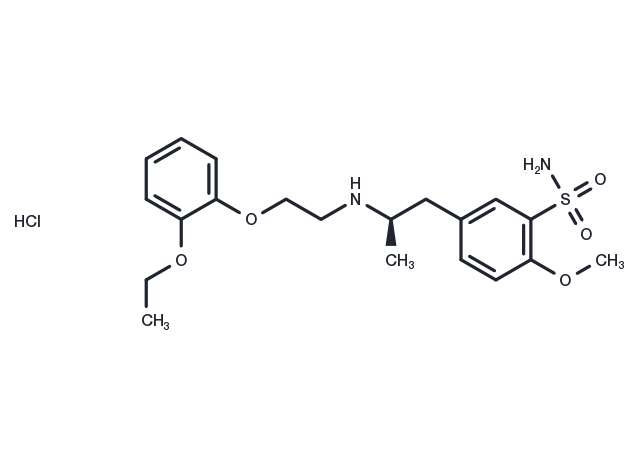Powder: -20°C for 3 years | In solvent: -80°C for 1 year


Tamsulosin hydrochloride (Flomax hydrochloride) is the hydrochloride salt of tamsulosin, a sulfonamide derivative with α1 adrenergic antagonist activity.

| Pack Size | Availability | Price/USD | Quantity |
|---|---|---|---|
| 10 mg | In stock | $ 33.00 | |
| 25 mg | In stock | $ 50.00 | |
| 1 mL * 10 mM (in DMSO) | In stock | $ 42.00 |





| Description | Tamsulosin hydrochloride (Flomax hydrochloride) is the hydrochloride salt of tamsulosin, a sulfonamide derivative with α1 adrenergic antagonist activity. |
| In vivo | Tamsulosin exhibits high plasma-protein binding, largely to α1-acid glycoprotein. It is metabolized, mainly by cytochrome P450 (CYP) 3A4 and CYP2D6 to compounds with low abundance, and 8.7–15% of an oral dose is excreted renally as the parent compound. The pharmacokinetics of tamsulosin are not affected to a major extent by age, and pharmacokinetic alterations in renally impaired patients relate largely to an increased concentration of α1-acid glycoprotein. Pharmacokinetic alterations with hepatic impairment are also only moderate, thus neither renal nor mild to moderate hepatic impairment necessitates dose adjustment. Early studies of tamsulosin IR in experimental animals, such as rats and dogs, showed rapid absorption of tamsulosin after oral administration (within 30–90 minutes) but absolute bioavailability of only 7–23% in rats and 30–42% in dogs. The absolute bioavailability of tamsulosin MR in fasted humans is approximately 100%. The tmax is typically about 5 hours (reported range of mean values 2.9-5.6 hours) in the fasted state and about 6 hours in the fed state (range 5.2-7.0 hours). Animal studies involving intravenous injection of radiolabelled tamsulosin and measurement of radiolabel in various tissues after 10 minutes have shown the presence of the drug in various tissues, ranked in the following order: kidney>lung≈heart>submaxillary gland>liver ≈spleen≈aorta≈vas deferens> prostate>>cerebral cortex, the latter being close to detection limits. Tamsulosin may not pass the blood-brain barrier. |
| Synonyms | Flomax, Flomax hydrochloride |
| Molecular Weight | 444.97 |
| Formula | C20H29ClN2O5S |
| CAS No. | 106463-17-6 |
Powder: -20°C for 3 years | In solvent: -80°C for 1 year
DMSO: 44.5 mg/mL (100 mM)
H2O: 4.5 mg/mL (10 mM)
You can also refer to dose conversion for different animals. More
bottom
Please see Inhibitor Handling Instructions for more frequently ask questions. Topics include: how to prepare stock solutions, how to store products, and cautions on cell-based assays & animal experiments, etc.
Tamsulosin hydrochloride 106463-17-6 GPCR/G Protein Neuroscience Adrenergic Receptor Flomax LY 253351 Flomax hydrochloride LY-253351 Inhibitor LY253351 Beta Receptor inhibit Tamsulosin Flomax Hydrochloride Tamsulosin Hydrochloride inhibitor
